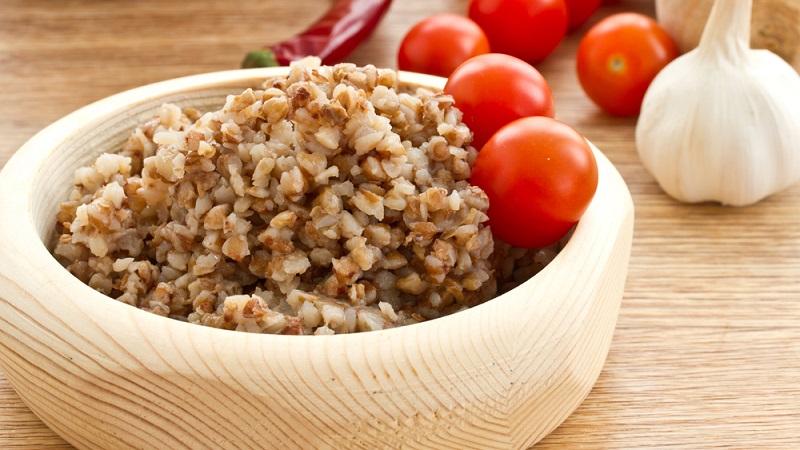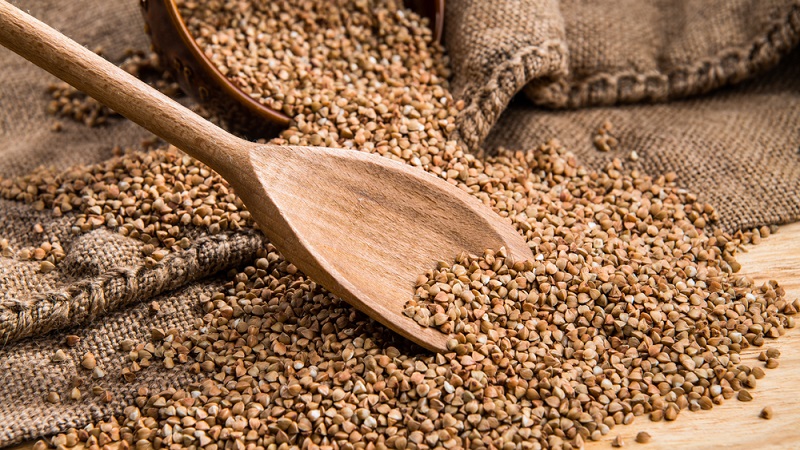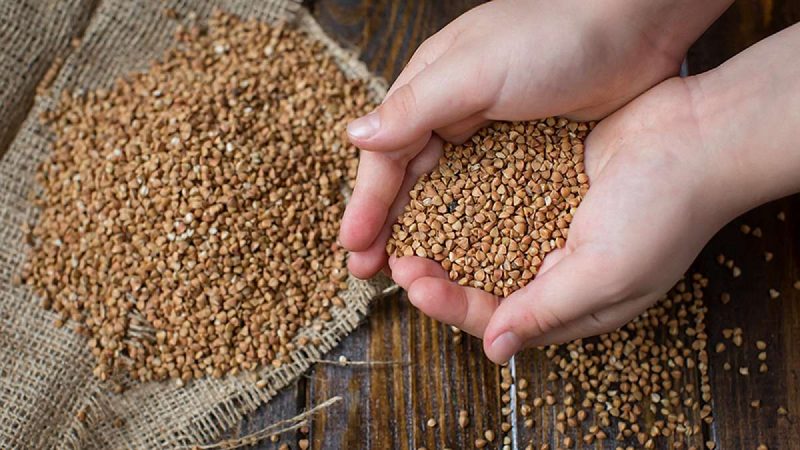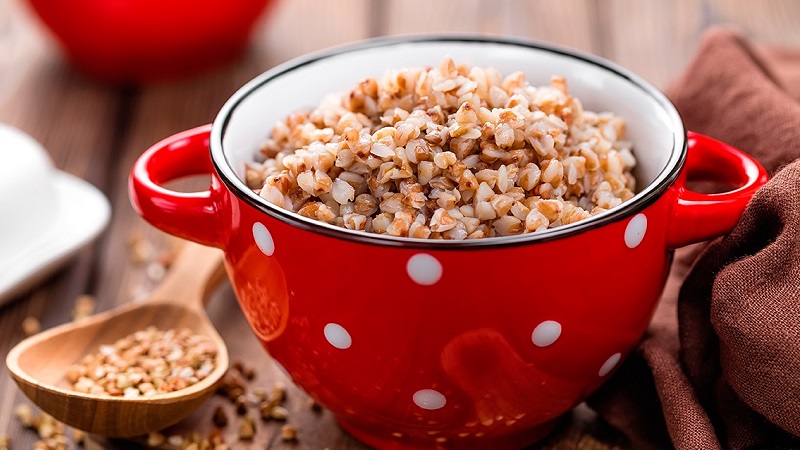What is the glycemic index of buckwheat
By eating properly, a person provides the body with all the necessary substances (vitamins, minerals, amino acids) that support health and well-being. When choosing products, pay attention to calorie content, balance of proteins, fats and carbohydrates, glycemic index.
Buckwheat is included in the daily menu of those who have decided to eat right. Its beneficial and dietary properties depend on many factors: the variety of cereals, storage and growing conditions, and the method of preparation.
The content of the article
What is the glycemic index
The glycemic index (GI) is an indicator that characterizes the rate of breakdown and conversion of carbohydrates into glucose, the rate of increase in blood sugar corresponding to the production of insulin.
Products with a low GI (up to 55 units) are absorbed more slowly, gradually supply the blood with glucose, ensuring even energy consumption, and do not overload the pancreas. The released energy is enough for several hours, while it is consumed by the body, and does not accumulate in the form of fatty deposits.
Foods with a high glycemic index (70 and above units) dramatically increase blood sugar and serve as a source of large amounts of energy. The body reacts to an increase in glucose levels with increased production of insulin, the main function of which is to normalize blood sugar levels.
All glucose that is not spent on vital functions accumulates in the fat cells, which contributes to weight gain. Excessive production of insulin inhibits the breakdown of fat in adipose tissue. When eating foods with a high GI, the energy intake exceeds the consumption, and its surplus is stored in the form of body fat.
Why is the glycemic index calculated, how it affects the body
Those who want to lose weight need to pay attention to the glycemic index. This is an effective way to correct excess weight... Eating foods with a GI of 70 or more interferes with fat burning and promotes its accumulation. Another problem with such products is their high calorie content. Usually they contain a lot of calories, while they are poorly satiated, and in the near future there is a feeling of hunger. It is important to limit the amount of foods with a high glycemic index to lose weight or maintain it at a given level.
The lower the GI of low-carbohydrate foods, the better they saturate the body and provide a more even energy expenditure.
Nutrition according to the glycemic index should be observed by patients with diabetes mellitus, with insulin resistance syndrome. Foods with a high GI cause hyperglycemia - an increase in blood glucose over normal levels.
For diabetics, this condition threatens the progression of diabetes mellitus, the development of possible complications of this disease. Prolonged high blood sugar levels overload the pancreas, leading to damage to the vessels and organs responsible for blood supply.
A diet with a low glycemic index ensures the normal course of a number of physiological processes:
- healthy pregnancy;
- maintaining heart function;
- ensuring energy reserves at the required level;
- increasing mental potential, physical endurance and performance;
- health of eyes and skin.
Indicators of GI values
For the established unit of measurement, take the unit of change in the increase in blood sugar after consuming glucose. Its glycemic index is taken as 100 units.
There are three food groups:
- low GI - 55 units and below;
- average GI - 56-69 units;
- high GI - 70 units and above.
Buckwheat: the glycemic index of the product in different states
The glycemic index is a relative value. It depends on a number of factors: the rate of enzymatic reactions in the intestine, the method of heat treatment of the product, the combination with other ingredients, and the temperature of the product.
Boiled

The GI of buckwheat boiled in water is equal to 40 units. Usually, cooking food and prolonged heat treatment increases their GI. In the case of buckwheat, the opposite happens, the carbohydrate index decreases during the cooking process, which is associated with the ability of the cereal to absorb water. However, water reduces not only GI, but also the amount of compounds useful for the body.
In order to maximize the preservation of the natural chemical composition, nutritionists recommend not to cook buckwheat, but to steam it with boiling water overnight in a ratio of 1: 2.
For reference. The temperature of the product also affects the carbohydrate index: carbohydrates from hot porridge are absorbed faster than from cooled ones.
Green
GI green buckwheat lower than roasted (brown) and is initially 15 units.
When processing grain, only the surface shell is removed, and all useful substances are preserved almost in full. Also, green cereals are not subjected to deep heat treatment, which reduces the amount of vitamins, minerals, amino acids, flavonoids.
Raw

The glycemic index of raw buckwheat varies between 50-60 units and depends on the degree of roasting of the grain, growing conditions and storage... The carbohydrate index is influenced by the combination with other foods.
To keep the glycemic index at an average level, it is not recommended to season porridge with sweet yogurt, jam, sugar, use with boiled carrots, beets, corn, pickled vegetables, fatty meat, smoked meats, sausages, sauces, seasonings, canned food. Buckwheat goes well with fresh vegetables, garden herbs, dietary meat.
Council. If eating unleavened porridge is unacceptable for you, you can add a little natural soy sauce, olive oil, baked onions.
What can reduce the hypoglycemic index of buckwheat dishes
Fiber acts as a balance substance. It reduces the rate of absorption of carbohydrates, provides the body with energy for a long time, removes toxins, excess bad cholesterol from the body. The most suitable in terms of dietary fiber content are unground (whole grains, peeled from the surface shell) and green buckwheat.
A lot of fiber is found in such foods:
- vegetables: broccoli, cauliflower, pumpkin, carrots;
- fruits and berries: strawberries, avocado, grapefruit, raspberries;
- dried fruits;
- seeds and nuts.
The ripeness of vegetables and fruits also affects the level of the carbohydrate index. Unripe and mature foods have a lower GI than overripe foods. Undercooked vegetables are more beneficial than overcooked ones.
How to lower the GI of buckwheat? There is another way - steaming. Unlike the usual cooking of porridge, with this method, starch does not turn into easily digestible carbohydrates and does not provoke excess weight gain.
Calorie buckwheat

In the process of cooking, the nutritional value of cereals is reduced by three times. Calorie content buckwheat boiled in water without oil and salt is 100.9 kcal. The presence of proteins and carbohydrates in the composition with a minimum fat content makes buckwheat a product of high dietary value.
The cereals combine vitamins of group B, A, C, H, macro- and microelements (calcium, potassium, magnesium, sodium, iron, phosphorus, selenium, copper, zinc and others), but most importantly - a high content of insoluble vegetable fiber. It enhances bowel function, removes bad cholesterol, cleanses the intestines from toxic substances, normalizes metabolism, and stimulates the removal of fat from the liver.
A buckwheat diet allows not only to gradually get rid of unnecessary kilograms, but also contributes to the all-round improvement of the body.
Useful properties of buckwheat for the body
Polyunsaturated fatty acids in cereals support the conversion of proteins and fats, and lower cholesterol levels. Also, omega-3 and omega-6 fatty acids stabilize blood pressure, reduce the risk of cardiovascular pathologies, prevent thrombus formation, and reduce manifestations of vascular spasm.
Thanks to the fiber, buckwheat helps to restore the intestinal microflora, improves digestion, and accelerates the breakdown of fats. Due to the presence of a large amount of dietary fiber, buckwheat is recommended to be used to cleanse the body of accumulated toxins and toxins as a result of malnutrition.
Buckwheat porridge is useful for people who have problems with the digestive tract. It reduces the severity of symptoms of intestinal irritation, increases the protection of mucous membranes, and has a mild laxative effect.
Zinc in cereals is important for women's health: it protects against hormonal imbalance, supports sexual activity, and regulates ovarian function. Buckwheat is especially useful during pregnancy, since the active components are involved in the development of the endometrium, which is necessary for successful implantation, fixation of the ovum, and in the future - for the normal development of the fetus.
For reference. Zinc has a beneficial effect on the condition of hair, nails, skin, together with vitamins B6 and E, accelerates the healing process of the skin and mucous membranes.
Buckwheat is rich in flavonoids, which have a pronounced antibacterial and anti-inflammatory effect, reduce capillary permeability and fragility, and inhibit blood coagulation. In addition, these powerful antioxidants protect cells from free radical damage.
Buckwheat provides the body with iron. A deficiency of this element leads to muscle weakness, anemia, increased fatigue, and atrophic gastritis. Buckwheat serves as a source of phosphorus, an insufficient intake of which can cause bone disease.
B vitamins increase brain activity, stimulate thinking, reduce stress, normalize night sleep, improve memory and concentration.
Buckwheat has a positive effect on the functioning of the kidneys, liver and organs of the urinary system, removing excess fluid from the body and eliminating puffiness. Its systematic use will help to successfully resist the development of arterial hypertension and the complications associated with this disease: ischemia, heart failure, atherosclerosis.
Application features
Buckwheat porridge can be present in the diet every day, most importantly - at least 2-3 times a week.

In the diet for various diseases
Buckwheat is recommended for people with impaired liver and kidney function to improve blood flow in the liver vessels, prevent bile stagnation, cleanse toxins, restore the structure and function of organs. For 10 days, they eat buckwheat steamed overnight for breakfast in the amount of 1-2 tbsp. l. with the addition of vegetable oil. After eating, do not drink or eat for 2-3 hours. Then they take a break and repeat the treatment after 10 days.The complete course consists of three approaches.
Buckwheat is useful for diseases of the pancreas and the organs of the digestive system. It acts as an anti-inflammatory, wound healing, enveloping agent, relieves the severity of symptoms. Taking into account the peculiarities of the disease, patients are offered crumbly buckwheat porridge, in a semi-liquid or grated form.
Buckwheat porridge helps prevent hyperkalemia and possible complications associated with diabetes. To do this, steamed buckwheat is systematically used in combination with foods rich in proteins and fiber.
Buckwheat steamed overnight helps to establish the process of emptying the intestines, to alleviate the health of people with diseases of the musculoskeletal system (rheumatism, gout, osteochondrosis). Steamed buckwheat porridge should be present in the menu of patients with arterial hypertension and prone to high blood pressure.
Slimming
Due to the wide popularity of buckwheat for weight loss, there is a variety of dietary regimens based on it. Based on the desired result and the capabilities of the body, the optimal option for duration and diet is selected.
Fasting day
Meals consist in using 250 g of steamed buckwheat throughout the day. The cooked porridge is divided into 5-6 meals at regular intervals - 2-3 hours. At the same time they drink a lot of water, green tea without sugar, still mineral water.
This diet allows you to maintain a given weight or bounce back after a period of prolonged overeating. On average, from 0.5 to 1 kg of weight per day goes away, mainly due to the removal of excess fluid, toxins and toxins from the body.
Buckwheat mono-diet for three days
The classic diet option combines adequate efficacy with minimal health risks. The ration of one day consists of 250 g of buckwheat, steamed overnight with boiling water in a 1: 2 ratio without spices, oil, sauces. The cooked porridge is divided into 5-6 equal portions. In between meals, they drink water or green tea, freshly squeezed vegetable / fruit juice. If you feel a pronounced feeling of hunger, as a snack, you can afford a small portion of fresh or steamed vegetables, fruits, dried fruits. Three days of strict nutrition will take away 1.5 to 3 kg of weight.
Diet on buckwheat for 5 days

It means eating two food products - kernel cereals and low-fat kefir. Buckwheat is poured with kefir overnight, in the morning it is divided into 5 equal portions. Drinking regime - 1.5-2.5 liters of water per day. With strict adherence to the diet, you can get rid of 2-4 extra pounds.
Buckwheat diet for 7 days
The basis of the diet is buckwheat steamed or cooked without salt and oil. Only minimal amount of olive oil, natural soy sauce, low-calorie yogurt / kefir are allowed. Porridge is complemented with fresh vegetables, garden herbs. As a snack, you can have a little fruit (except for grapes and bananas), dried fruits. The result of losing weight varies between 5-7 kg.
Buckwheat diet for 14 days
The safest and most gentle dietary food option. The bottom line is the use of boiled / steamed buckwheat with other products from the list of allowed. These include vegetables, fruits, berries, dairy and sour milk products with a low fat content, lean meat and fish, rye bread, cheese, eggs. Drink at least 1.5 liters of clean water every day. Weight loss indicators fluctuate around 6-8 kg, with regular physical activity - 8-10 kg.
Contraindications
There are few contraindications to the use of buckwheat. Among them are such diseases and conditions:
- individual intolerance to the product;
- severe urolithiasis;
- peptic ulcer and gastritis in the acute stage.
Buckwheat diet as a weight loss method is not suitable for children, adolescents, elderly people, pregnant women and lactating women. An unbalanced diet can negatively affect general well-being, health, growth and development processes.
Conclusion
Buckwheat is a valuable food product characterized by low calorie content, low carbohydrate index and rich vitamin and mineral composition. This makes cereals indispensable in medical and dietary nutrition. Buckwheat has a tangible effect in losing weight, treating and preventing diseases of the organs of vision, musculoskeletal system, heart and blood vessels, digestive, urinary and nervous systems.
Useful properties of buckwheat and nutritional value depend on the variety and method of heat treatment. To reap the maximum benefits for health and shape, nutritionists recommend eating kernel steamed with boiling water or green buckwheat.